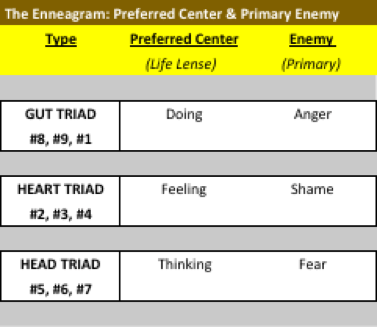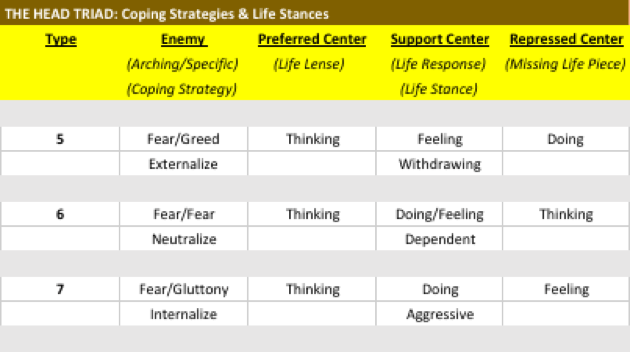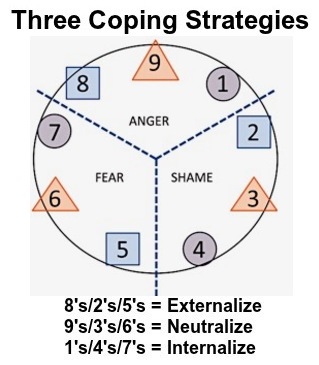Nine Enneagram Personalities: Nine Unique Ways Our Triune Brain Deals With Life.
The human brain has three “power centers” (GUT=Doing, HEART=Feeling, HEAD=Thinking) and each of these power centers has the capability of navigating us through life’s ups and downs. Keep in mind as well, that each of the three triads (GUT, HEART, HEAD) has a specific enemy to be overcome.

THE GUT TRIAD: (Enneagram #8, #9, #1) Doing-oriented, knowing-driven, body-centered, decisions from the gut, power-focused. When encountering life, the first reaction is to do something. Tends to act before thinking or feeling. Anger is always waiting beneath the surface.
THE HEART TRIAD: (Enneagram #2, #3, #4) Feeling-oriented. feeling-driven, emotionally-centered, decisions from the heart, people-focused. When encountering life, the first reaction is to feel something. Tends to feel before doing or thinking. Shame is always waiting beneath the surface.
THE HEAD TRIAD: (Enneagram #5, #6, #7) Thinking-oriented, thinking-driven, mentally-centered, decisions from the head, provision-focused. When encountering life, the first reaction is to think and plan. Tends to overthink things before feeling or doing. Fear is always waiting beneath the surface.
Nine Enneagram Personalities: Our Support and Repressed Centers & Unique Enemy
Once a Preferred Center and Primary Enemy is established in our life, the Enneagram can now help us go into more detail by identifying nine varying patterns we utilize when prioritizing our approach to life.
First, while each Center has an arching emotional enemy (Gut = Anger, Heart = Shame, Head = Fear) the Enneagram also offers us a much more detailed report in identifying a specific enemy that corresponds with each of the nine personality types. As we mentioned earlier, these specific enemies are based on the seven deadly sins (pride, greed, lust, envy, gluttony, wrath, and sloth) with deceit and fear added to bring the type numbers to nine.
Secondly, each of the nine Enneagram personality styles has a unique priority system which is comprised of 1) a Life Lense: our Preferred (Dominant) Center through which we view life; 2) a Life Response: a Support (Secondary) Center that reacts to and supports our first perceptions, leaving 3) a Missing Life Piece: a Repressed (or under-used, under-developed) Center which sadly eliminates (or under-uses) a much-needed component for doing life well.
A completely healthy and whole human being, free from life’s pain and struggles, would have a balanced approach to all three power centers, but because “life happens”, we tend to live our lives through one power center, using a secondary center to process and respond to life, leaving the third center suppressed or relatively under-used and/or under-developed.
Below is a chart which helps you see how your Enneagram personality type responds to life.

Let me give you an example of how the info on the chart plays out in my own life. For me, a #2 (Helper) on the Enneagram, my truest enemies are Shame and Pride. My Preferred Center is the Feeling triad, so as I take in life, I perceive it, first and foremost, through my feelings. My secondary Support Center is Doing, and my Repressed Center is Thinking. This means that when I’m left to my own devices, I will view life through my Life Lense of my Feeling Center, and then quickly go over to my Doing Center (Life Response), acting on my feelings without much (if any) help from my Thinking Center (Missing Life Piece). All the while, I’m battling Shame and Pride, hoping as a #2 Helper that my hard work in “helping” others will give me the appreciation and love I’m searching for deep inside.
Nine Enneagram Personalities: Our Coping Strategies and Life Stances
Within each triad (Gut, Heart & Head) the Enneagram points out that each one of us will generally choose one of three unique “Coping Strategies” when responding to the world around us. Coping Strategy #1 is to Externalize, looking outwardly as we attempt to find the source of our battles. Coping Strategy #2 is to Neutralize, hoping an out-of-sight-out-of-mind approach will help us survive. Finally, Coping Strategy #3 is to Internalize, looking inwardly as we strive to find the source of our problems.
When it comes to our emotional enemies (Anger, Shame, Fear, etc.) each one of us tends to cope with our emotions in the same way we cope with life. We Externalize. We Neutralize. We Internalize. If you look at the chart above, you’ll see that each of these three Coping Strategies is found within one of the three Enneagram types in each preferred center.
So, how do you cope with life’s problems? What’s your strategy? How do you handle your emotions?
Your one answer to these “coping” questions just might help you in confirming your unique personality type as it differentiates from the other two found in your power center/triad.
Secondly, the Enneagram identifies what Suzanne Stabile calls “Life Stances” or three different ways of moving through the world. Stance #1 is found in 3’s, 7’s & 8’s, and is called the Aggressive stance where we run at people as we respond to life’s problems. Stance #2 is found in 1’s, 2’s, & 6’s, and is called the Dependent stance where we come alongside people, relying upon our relationships to help us cope. Stance #3 is found in 4’s, 5’s, & 9’s, and is called the Withdrawing stance where we move away from people, preferring to deal with life on our own.
Following are three charts that give us all nine Enneagram types and the corresponding Coping Strategies and Life Stances:

The major preoccupation of the Gut triad is anger. 8’s see life’s problems as an external one, reducing anger by aggression and bullying, by being in charge and calling the shots. The strategy of 9’s is to neutralize and repress anger, withdrawing and being conciliatory by creating a comfortable, disturbance-free world in which there is no cause for anger. 1’s perceive the problem as an internal one, tackle anger by perfecting themselves and then going out in the world to co-create with others a perfect place in which there is no cause for anger.

Those in the Heart Triad sense shame and are preoccupied with image and acceptance. 2’s see the solution to be found in their outside world, overcoming shame through dependency upon others, hoping warmth and helpfulness can win the day. The strategy of 3’s is to forget about the shame while gaining the applause of others through their aggressive attempts at success and achievement. 4’s internalize the shame, hoping to accomplish acceptance by pulling away from the world, achieving attention and admiration by being unlike others, following the beat of a different drummer.

Those of the Head Triad are driven by fear and do everything they can to reduce anxiety surrounding that fear. 5’s see the outside world as the primary source of much of their pain. Thus, they reduce fear by withdrawing, so they can gather more and more facts, keeping their distance from the messiness of life. 6’s are rarely in touch with their specific fears, but know that anxiety can be overcome by following the rules of others, coloring between the lines, obeying authority, serving others, and staying out of trouble. Safety and security are paramount. 7’s see their fear as something they’ve created through their own actions and attempt to reduce anxiety and fear by living an aggressive, devil-may-care life that maximizes pleasure.

Once again, I’ll give you my personal example to see how it all works. As a #2 Helper, I take in life through my Preferred Center of Feeling. As you can see (above) my Coping Strategy is to Externalize my issues with Shame and Pride, making me believe that most of my problems come from outward causes and will be solved through external activity. Next, notice how my Support Center (Doing) is lived out in a Dependent stance, meaning I’m very dependent upon others to help me solve my core issues of Shame and Pride. So without much help from my Repressed Center (Thinking) I rarely take the time to clearly meditate or ponder over my issues, but quickly act (Doing) to help me find the love and appreciation I long for in my life.
So, how will I know when I’ve arrived at my Enneagram personality number?
You will know it. Waves of relief and embarrassment, of elation and chagrin, are likely to sweep over you. Things that you have always known unconsciously about yourself will suddenly become clear, and life patterns will emerge. You can be sure when this happens, you have identified your personality type correctly. Don Richard Riso & Russ Hudson
In truth, the Enneagram has a very uncanny way of addressing why things aren’t going so well for us! But the good news is that in Christ, all of these less-than-perfect life strategies can be redeemed, bringing us to a greater appreciation of the unique personality God has given each of us, thus learning to live life to the full!
I have come that they may have life, and have it to the full. Jesus of Nazareth John 10: 10 (NIV)
Go on to the following resources:


